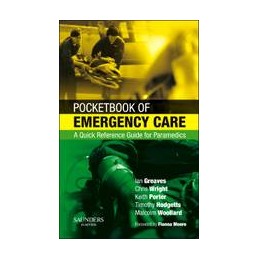- Reduced price

Order to parcel locker

easy pay


 Delivery policy
Delivery policy
Choose Paczkomat Inpost, Orlen Paczka, DHL, DPD or Poczta Polska. Click for more details
 Security policy
Security policy
Pay with a quick bank transfer, payment card or cash on delivery. Click for more details
 Return policy
Return policy
If you are a consumer, you can return the goods within 14 days. Click for more details
The Pocketbook of Emergency Care is the first text designed for use by the professional paramedic at the roadside. The contents are formatted to be easily accessible when specific information is required in the emergency situation. Although aimed at paramedics it is a useful, practical handbook for emergency medical technicians, advanced first aiders, combat medical technicians and practitioners of emergency medical care in remote and rural environments. The book covers the immediate management of acute medical emergencies, major trauma, minor injuries and environmental problems as well as covering the interaction with other emergency services and coping with major incidents. The pocketbook is an up-to-date synopsis of prehospital emergency medicine and includes the most recent European Resuscitation Council algorithms along with recent military medical advances in the management of major trauma patients. The text is based on the popular Emergency Care Textbook for Paramedics, also published by Saunders Elsevier, which can be used as a reference text in conjunction with the Pocketbook.
Data sheet
1. Approaching the scene
2. Approach to the Patient
3. An introduction to clinical examination
4. The Emergency Services
5. Basic life Support
6. Basic management of the airway and ventilation
7. Advanced management of the airway and ventilation
8. Intravascular access
9. Taking a medical history
10. Drug Formulary
11. Respiratory emergencies
12. The Cardiovascular System and the ECG
13. Assessment and monitoring
14. Cardiac arrest in adults: Advanced life support
15. Cardiovascular emergencies
16. The Unconscious Patient
17. The acute abdomen
18. Poisoning
19. Microbiology and Infection
20. Trauma
21. The primary and secondary survey
22. Shock
23. Head Injuries
24. Facial Injuries
25. Chest Injuries
26.Abdominal and genitourinary trauma
27. Bone and joint injuries
28. Spinal injuries
29. Patient Immobilization and Extrication
30. Blast and gunshot injuries
31. Burns
32. Wound management
33. Overview of Trauma Resuscitation
34. The Paediatric History
35. Assessment of the Paediatric Patient
36. The sick child
37. Paediatric cardiac arrest
38. The Injured Child
39. Care of the Elderly
40. Hypothermia
41. Near drowning
42. Heat illness
43. Electrocution
44. Chemical incident
45. Nuclear and Radiation Incidents
46. The Sports Arena
47. Rescue from Remote Places
48. Aeromedical Evacuation
49. Childbirth
50. Emergencies in pregnancy
51. Trauma in pregnancy
52. Neonatal Resuscitation and Transport
53. Substance abuse
54. The Uncooperative or Violent Patient
55. Psychiatric Emergencies
56. The Major Incident: an overview
57. Triage
58. The ambulance service at mass gatherings
59. Legal issues
